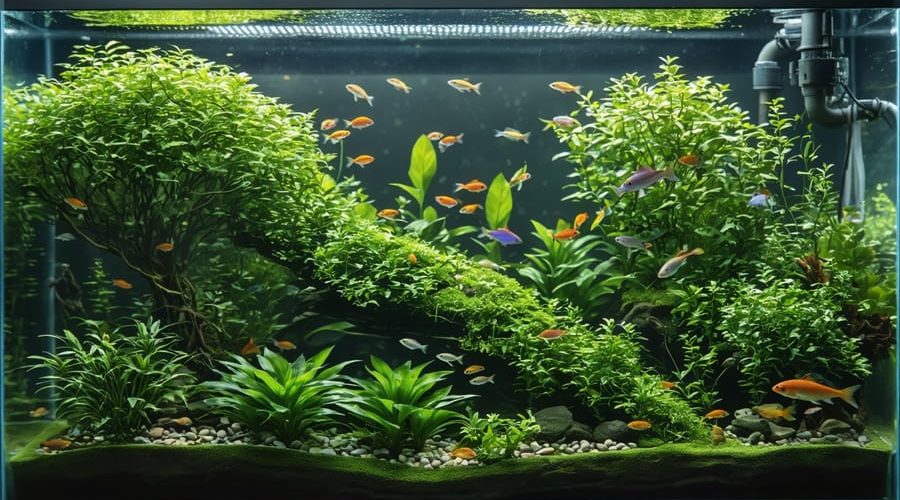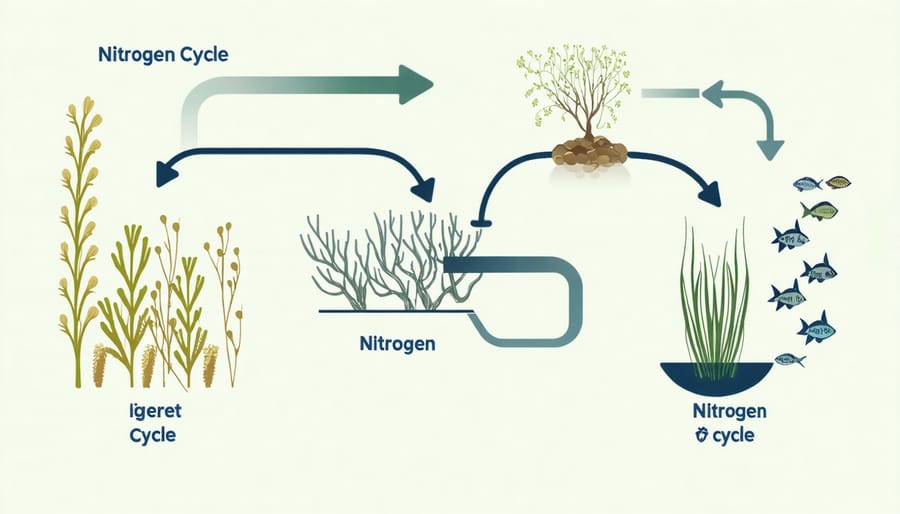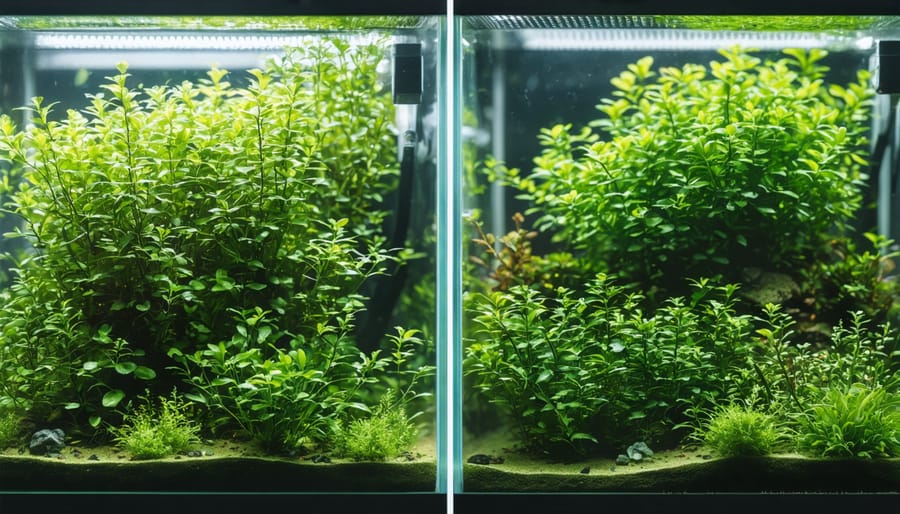
Perfect Balance: Creating a Thriving Planted Aquarium Ecosystem
A planted aquarium operates as a complex yet harmonious miniature ecosystem, where each element plays a vital role in creating a living underwater garden. Like nature’s delicate balance, these aquatic environments thrive on the intricate relationships between plants, fish, beneficial bacteria, and microscopic organisms. Water chemistry, light levels, and nutrient cycles work in concert to support photosynthesis, waste processing, and oxygen exchange. Understanding these ecological interactions transforms simple fish tanks into self-sustaining biotopes that mirror natural aquatic habitats. This living system requires careful consideration of plant selection, substrate composition, and water parameters to maintain its delicate equilibrium. When properly balanced, a planted aquarium becomes more than just a decorative feature—it’s a thriving ecosystem that largely maintains itself, requiring minimal intervention while providing maximum beauty and stability. The key to success lies in replicating nature’s time-tested processes while adapting them to the controlled environment of home aquaria.
The Foundation: Understanding Aquarium Ecosystems
The Nitrogen Cycle
The nitrogen cycle is the heart of a healthy planted aquarium, working like nature’s own filtration system. In your tank, beneficial bacteria break down harmful waste products into less toxic forms. This process starts when fish waste and uneaten food produce ammonia, which is highly toxic to aquatic life. Fortunately, certain bacteria convert this ammonia into nitrites, and then different bacteria transform these nitrites into nitrates.
While nitrates are less harmful, they still need management. This is where your aquatic plants become heroes – they absorb nitrates as fertilizer for growth. This natural process creates a beautiful balance: your fish provide nutrients for the plants, and the plants help keep the water clean for your fish.
To maintain a healthy cycle, avoid overfeeding your fish and resist the urge to clean too thoroughly – those beneficial bacteria live in your substrate and filter media. Regular water testing helps you monitor these invisible but essential processes, ensuring your underwater garden stays in perfect harmony.

Light and CO2 Balance
Light and carbon dioxide work together like dance partners in your planted aquarium. During photosynthesis, plants use light energy to convert CO2 and water into the sugars they need to grow. Getting this balance right is crucial for healthy plant growth and a thriving ecosystem.
Your aquarium lights should run for about 8-10 hours daily, mimicking natural daylight. Too much light without adequate CO2 can lead to algae problems, while too little light prevents plants from processing available carbon dioxide effectively. If you’re using standard aquarium lighting, your plants will do fine with the CO2 naturally produced by fish and bacterial processes.
However, if you’re using high-intensity lighting for demanding plants, you’ll need to supplement with CO2. This can be done through pressurized systems, DIY yeast setups, or liquid carbon supplements. Watch your plants for signs they need more CO2 – slow growth or yellowing leaves often indicate a carbon deficiency.
A good starting point is to ensure your lighting period matches your CO2 availability. Turn your CO2 on an hour before lights come on and off an hour before lights go out. This creates a natural rhythm that your plants will thrive in.

Choosing the Right Plants
Foreground Plants
Foreground plants create the foundation of your aquarium’s landscape, acting as a lush carpet that ties the entire underwater garden together. The key to growing thriving aquatic plants at this level is choosing species that naturally remain low and spread horizontally.
Popular carpet plants like Dwarf Baby Tears (Hemianthus callitrichoides) and Monte Carlo (Micranthemum tweediei) create stunning ground cover when properly maintained. These plants thrive when planted in small clusters about an inch apart, allowing them to gradually spread and form a seamless carpet.
For beginners, hardier options like Dwarf Sagittaria and Marsilea hirsuta are more forgiving, requiring less intense lighting and CO2 supplementation. These plants still create beautiful foreground coverage while being easier to maintain.
To encourage dense, low growth, regular trimming is essential. Use sharp aquascaping scissors to trim the tops of your carpet plants when they reach about 2 inches in height. This promotes horizontal spread and prevents the plants from becoming too tall or leggy.
Remember to plant foreground species after establishing your substrate but before adding water to your tank. This makes it easier to secure delicate plants and ensures they don’t float away during the initial setup phase.
Background and Accent Plants
Background and accent plants form the backbone of your aquarium’s visual appeal, creating depth and natural transitions between different areas. Tall background plants like Vallisneria, Amazon Sword, and Jungle Val can create a lush forest effect, reaching heights of 12-24 inches when fully grown. These plants not only provide shelter for fish but also help conceal equipment like filters and heaters.
When selecting statement pieces, consider Red Tiger Lotus or Cryptocoryne balansae, which add dramatic focal points with their distinctive leaves and colors. These eye-catching plants should be placed strategically – typically in the middle ground or toward the back corners – to create visual interest without overwhelming the layout.
Layer your background plants by height, with the tallest specimens at the very back and gradually shorter ones moving forward. This creates a natural-looking slope that draws the eye through the aquascape. For best results, plant them in groups of odd numbers, which tends to look more natural than even-numbered groupings.
Remember that these larger plants are usually heavy root feeders, so they’ll benefit from root tabs or nutrient-rich substrate. Give them adequate spacing when planting, as they’ll need room to grow and spread. While they may look sparse initially, patience will reward you with a full, lush backdrop that transforms your aquarium into a stunning underwater landscape.
Creating Plant Communities
Compatible Plant Groups
Creating harmonious plant groups in your aquarium involves understanding which species naturally complement each other. Plants with similar aquatic plant adaptations tend to thrive together, making maintenance easier and creating a more stable ecosystem.
Foreground plants like Dwarf Hairgrass, Cryptocoryne, and Anubias nana work beautifully together, requiring similar light and nutrient levels. For the mid-ground, consider combining Java Fern with Amazon Sword plants, as they share comparable water parameter needs and growth rates.
Background plants such as Vallisneria and Hygrophila make excellent companions, both enjoying strong lighting and providing shelter for fish. Fast-growing stem plants like Rotala and Ludwigia can be grouped to create stunning red and green contrast while helping to prevent algae growth.
For beginners, starting with hardy plant combinations like Java Moss, Anubias, and Cryptocoryne is recommended. These plants are forgiving and adaptable, making them perfect companions for establishing your first planted aquarium ecosystem.
Avoiding Competition
In a planted aquarium, preventing competition between plants is crucial for a thriving ecosystem. Start by spacing plants according to their mature size, not their current dimensions. Fast-growing stem plants should be positioned behind slower-growing species to prevent shading. When choosing plants, group those with similar nutrient requirements together to avoid resource competition.
Consider root systems when planting. Aggressive root spreaders like Amazon Swords should be given ample space away from delicate species. Use root tabs strategically for heavy feeders while maintaining general water column fertilization for all plants.
Light management plays a vital role in reducing competition. Arrange plants by height, with carpeting plants in the foreground and tall species in the background. This natural terracing ensures each plant receives adequate light. For dense plantings, regular pruning prevents overshadowing and maintains healthy growth patterns.
Some plants release allelopathic substances that can inhibit the growth of others. Research plant compatibility before combining species, and maintain good water circulation to minimize any negative effects. Regular maintenance and observation help identify and resolve competition issues before they become problematic.
Maintaining Ecological Balance
Nutrient Management
Proper nutrient management is essential for maintaining healthy aquarium plants and a thriving underwater ecosystem. Plants need a balance of macronutrients (nitrogen, phosphorus, and potassium) and micronutrients (iron, magnesium, and trace elements) to grow successfully.
Regular fertilization can be achieved through root tabs for heavy-feeding plants and liquid fertilizers for water column feeders. Start with a basic all-in-one fertilizer if you’re new to planted tanks, and adjust based on your plants’ response. Watch for signs of deficiency like yellowing leaves or stunted growth, which indicate you may need to increase certain nutrients.
Water parameters also play a crucial role in nutrient uptake. Keep your pH between 6.5 and 7.5 for optimal nutrient absorption. Regular water changes of 20-30% weekly help maintain stable parameters and remove excess nutrients that could lead to algae growth.
CO2 levels are particularly important, as they directly affect how well plants can process nutrients. While low-tech tanks can succeed with basic fertilization, adding CO2 supplementation dramatically improves plant growth and nutrient utilization. For beginners, start with simple liquid carbon supplements before investing in pressurized CO2 systems.
Remember that every tank is unique, and it may take time to find the perfect balance for your setup. Start conservatively with fertilizers and adjust gradually based on plant growth and water quality tests.

Problem Prevention
Preventing problems in your planted aquarium is much easier than fixing them later. Start by avoiding overstocking – a good rule of thumb is one inch of fish per gallon of water. Regular water testing is essential; invest in a reliable test kit to monitor ammonia, nitrites, nitrates, and pH levels at least weekly.
Algae outbreaks are a common headache, but you can prevent them by maintaining proper lighting periods (8-10 hours daily) and avoiding overfeeding. Adding fast-growing plants from the start helps compete with algae for nutrients. Remember to remove dead or decaying plant matter promptly, as it can lead to water quality issues.
Another frequent issue is plant melting, especially with new setups. Prevent this by researching each plant’s requirements before purchase and ensuring your substrate, lighting, and CO2 levels match their needs. Start with hardy species like Anubias or Java Fern while you’re learning the ropes.
Watch out for nutrient deficiencies by establishing a consistent fertilization schedule. Signs like yellowing leaves or stunted growth can be avoided with regular dosing of both macro and micronutrients. Finally, maintain good water flow throughout the tank and clean your filter regularly to prevent dead spots where debris can accumulate and cause problems.
Creating and maintaining a planted aquarium is a rewarding journey that brings the beauty and complexity of natural aquatic ecosystems into your home. Throughout this guide, we’ve explored the fundamental elements that make these underwater gardens thrive – from understanding water chemistry and nutrient cycles to selecting the right combination of plants and establishing proper lighting conditions.
Remember that a successful planted aquarium is more than just adding plants to water; it’s about creating a balanced ecosystem where all components work together harmoniously. The key is to start small, be patient, and learn from your experiences. Even experienced aquarists continue to discover new techniques and insights as they tend to their underwater gardens.
As you begin your planted aquarium adventure, don’t be afraid to experiment while keeping the basic principles in mind. Monitor your water parameters regularly, maintain consistent maintenance routines, and make adjustments as needed. Join online communities and local aquarium clubs to share experiences and learn from others who share your passion.
The satisfaction of watching your plants pearl with oxygen, seeing your fish thrive among lush greenery, and creating your own slice of nature is truly unmatched. Whether you’re starting with easy-to-grow species or planning an elaborate aquascape, the journey of maintaining a planted aquarium will deepen your appreciation for aquatic ecosystems while providing endless opportunities for creativity and learning.
